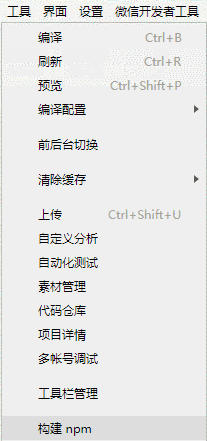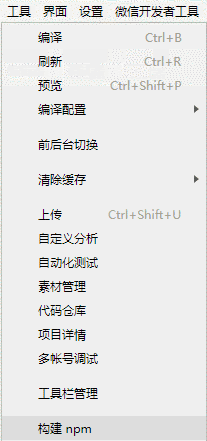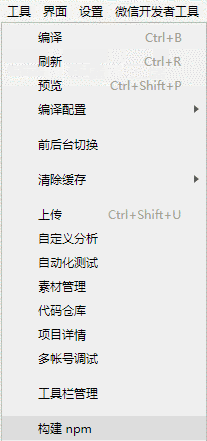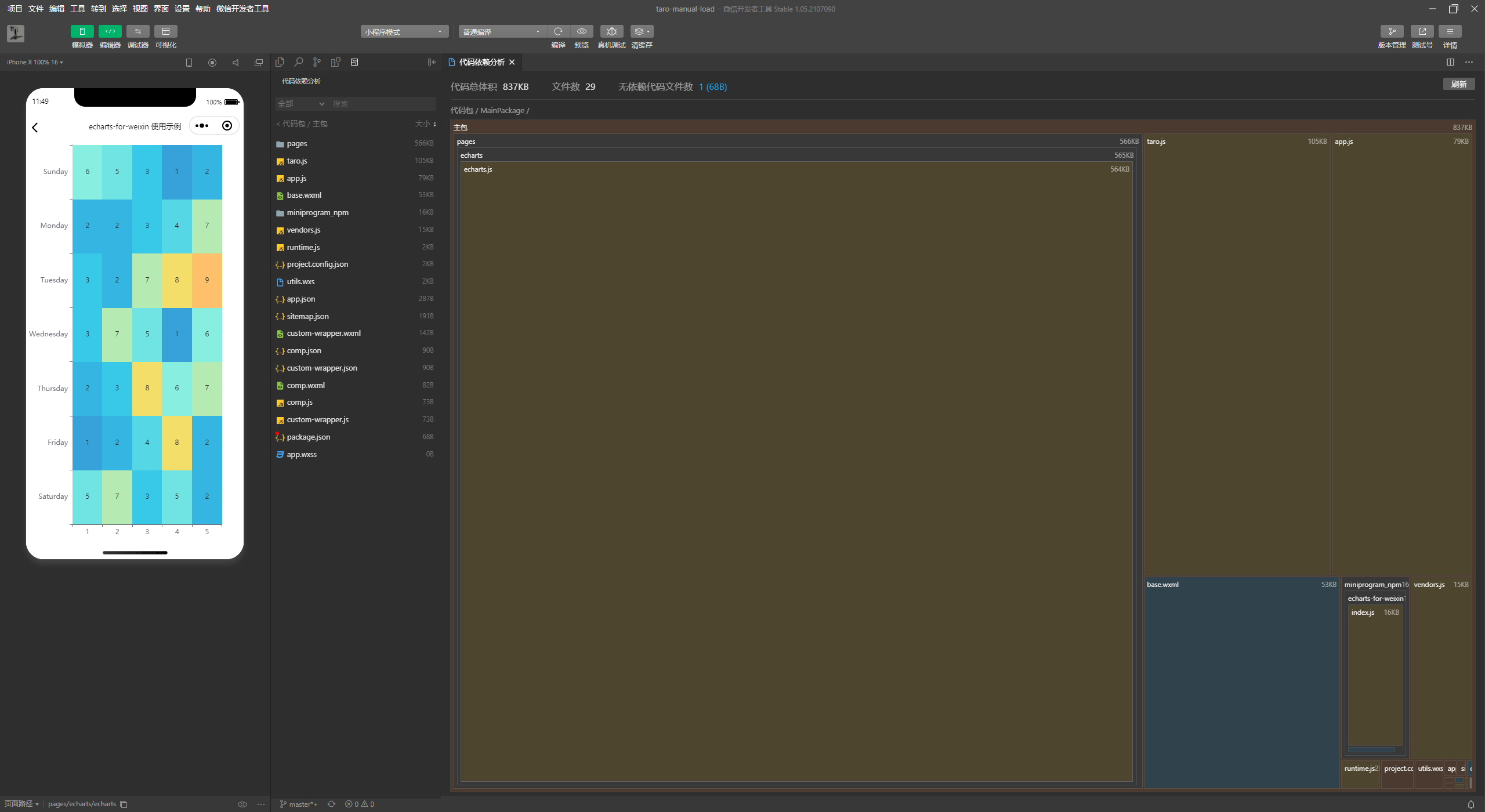Apache ECharts 官方提供了在微信小程序中使用Echarts 的代码实例和 ec-canvas 组件,但是未发布 npm 包。
此项目在官方代码之上修改支持 ec-canvas 组件传入 echarts 可支持 npm 引入 echarts 或本地自定义构建后的 echarts,更符合 Web 开发体验。
并且发布 npm 包,支持小程序通过 npm 安装使用。并支持 Taro 按需引入 echarts 减小打包体积。
安装
npm install echarts-for-weixin
小程序引用
参考代码 tools/demo
- 首先在页面的 json 文件加入 usingComponents 配置字段
{"usingComponents": {"ec-canvas": "echarts-for-weixin"}}
- 项目根目录创建
package.json并执行 npm install 安装依赖
{"dependencies": {"echarts": "^5.1.2","echarts-for-weixin": "^1.0.0"}}
- 小程序开发者工具中构建 npm
点击开发者工具中的菜单栏:工具 —> 构建 npm

- 在页面中引入
echarts,可以从npm引入echarts,也可以引入本地自定义构建的echarts以减小体积
import * as echarts from 'echarts' // 从 npm 引入 echartsimport * as echarts from './echarts' // 或者从本地引入自定义构建的 echarts
- 然后可以在对应页面的 wxml 中直接使用该组件
<view class="container"><ec-canvas id="mychart-dom-bar" canvas-id="mychart-bar" echarts="{{ echarts }}" ec="{{ ec }}"></ec-canvas></view>
ec-canvas的具体用法和如何初始化图表请参考 Echarts 官方小程序示例
import * as echarts from 'echarts'let chart = null;function initChart(canvas, width, height, dpr) {chart = echarts.init(canvas, null, {width: width,height: height,devicePixelRatio: dpr // new});canvas.setChart(chart);var option = {tooltip: {trigger: 'axis',axisPointer: { // 坐标轴指示器,坐标轴触发有效type: 'shadow' // 默认为直线,可选为:'line' | 'shadow'},confine: true},legend: {data: ['热度', '正面', '负面']},grid: {left: 20,right: 20,bottom: 15,top: 40,containLabel: true},xAxis: [{type: 'value',axisLine: {lineStyle: {color: '#999'}},axisLabel: {color: '#666'}}],yAxis: [{type: 'category',axisTick: { show: false },data: ['汽车之家', '今日头条', '百度贴吧', '一点资讯', '微信', '微博', '知乎'],axisLine: {lineStyle: {color: '#999'}},axisLabel: {color: '#666'}}],series: [{name: '热度',type: 'bar',label: {normal: {show: true,position: 'inside'}},data: [300, 270, 340, 344, 300, 320, 310],itemStyle: {// emphasis: {// color: '#37a2da'// }}},{name: '正面',type: 'bar',stack: '总量',label: {normal: {show: true}},data: [120, 102, 141, 174, 190, 250, 220],itemStyle: {// emphasis: {// color: '#32c5e9'// }}},{name: '负面',type: 'bar',stack: '总量',label: {normal: {show: true,position: 'left'}},data: [-20, -32, -21, -34, -90, -130, -110],itemStyle: {// emphasis: {// color: '#67e0e3'// }}}]};chart.setOption(option);return chart;}Page({data: {echarts,ec: {onInit: initChart}},onReady() {setTimeout(function () {// 获取 chart 实例的方式console.log(chart)}, 2000);}})
Taro 引用
参考代码 examples/taro
准备工作
- 安装依赖
npm install echarts-for-weixin
- 在项目根目录中新建文件
project.package.json或者自定义命名,此文件是小程序的package.json,并在下一步中添加小程序自定义构建 npm 方式。这么做的目的是为了能够共享项目node_modules - 在
project.config的setting中添加小程序自定义构建 npm 方式,参考 自定义 node_modules 和 miniprogram_npm 位置的构建 npm 方式
{"setting": {"packNpmManually": true,"packNpmRelationList": [{"packageJsonPath": "../project.package.json","miniprogramNpmDistDir": "./"}]}}
- 执行
Taro的开发或者打包命令进行项目开发
npm run dev:weapp
- 小程序开发者工具中构建 npm。注意:小程序开发工具打开的项目目录是
dist文件夹
点击开发者工具中的菜单栏:工具 —> 构建 npm

引入 Echarts
- 在全局的
app.config.js中添加或者在单个需要使用到echarts的页面配置中添加引用组件
{"usingComponents": {"ec-canvas": "echarts-for-weixin"}}
- 在页面中引入
echarts,可以从npm引入echarts,也可以引入本地自定义构建的echarts以减小体积
import * as echarts from 'echarts' // 从 npm 引入 echartsimport * as echarts from './echarts' // 或者从本地引入自定义构建的 echarts
- 将引入的
echarts传给组件
<ec-canvasid='mychart-dom-area'canvas-id='mychart-area'echarts={echarts} // 将引入的 echarts 传给组件ec={this.state.ec}/>
ec-canvas的具体用法和如何初始化图表请参考 Echarts 官方小程序示例
function initChart(canvas, width, height) {const chart = echarts.init(canvas, null, {width: width,height: height})canvas.setChart(chart)const model = {yCates: ['Saturday', 'Friday', 'Thursday','Wednesday', 'Tuesday', 'Monday','Sunday'],xCates: ['1', '2', '3', '4', '5'],data: [// [yCateIndex, xCateIndex, value][0, 0, 5], [0, 1, 7], [0, 2, 3], [0, 3, 5], [0, 4, 2],[1, 0, 1], [1, 1, 2], [1, 2, 4], [1, 3, 8], [1, 4, 2],[2, 0, 2], [2, 1, 3], [2, 2, 8], [2, 3, 6], [2, 4, 7],[3, 0, 3], [3, 1, 7], [3, 2, 5], [3, 3, 1], [3, 4, 6],[4, 0, 3], [4, 1, 2], [4, 2, 7], [4, 3, 8], [4, 4, 9],[5, 0, 2], [5, 1, 2], [5, 2, 3], [5, 3, 4], [5, 4, 7],[6, 0, 6], [6, 1, 5], [6, 2, 3], [6, 3, 1], [6, 4, 2]]}const data = model.data.map(function (item) {return [item[1], item[0], item[2] || '-']})const option = {tooltip: {position: 'top'},animation: false,grid: {bottom: 60,top: 10,left: 80},xAxis: {type: 'category',data: model.xCates},yAxis: {type: 'category',data: model.yCates},visualMap: {min: 1,max: 10,show: false,calculable: true,orient: 'horizontal',left: 'center',bottom: 10,inRange: {color: ['#37A2DA', '#32C5E9', '#67E0E3', '#91F2DE', '#FFDB5C', '#FF9F7F'],}},series: [{name: 'Punch Card',type: 'heatmap',data: data,label: {normal: {show: true}},itemStyle: {emphasis: {shadowBlur: 10,shadowColor: 'rgba(0, 0, 0, 0.5)'}}}]}chart.setOption(option)return chart}export default class Echarts extends React.Component {state = {ec: {onInit: initChart}}render () {return (<View className='echarts'><ec-canvasid='mychart-dom-area'canvas-id='mychart-area'echarts={echarts}ec={this.state.ec}/></View>)}}
Taro 按需引用
参考代码 examples/taro-manual-load
注意:小程序开发者工具打开的项目目录是打包后的 dist 目录
准备工作
- 安装依赖
npm install echarts-for-weixin
- 在项目根目录中新建文件
project.package.json或者自定义命名,此文件是小程序的package.json,并在下一步中添加小程序自定义构建 npm 方式。并配置config/index.js中的copy选项,将project.package.json复制到dist目录下并且重命名为package.json。并且复制node_modules/echarts-for-weixin至dist/node_modules/echarts-for-weixin避免在小程序开发者工具中打开的项目重新安装依赖
config/index.js
{copy: {patterns: [{ from: 'project.package.json', to: 'dist/package.json' }, // 指定需要 copy 的文件{ from: 'node_modules/echarts-for-weixin/', to: 'dist/node_modules/echarts-for-weixin/' }],options: {}}}
- 在
project.config的setting中添加小程序自定义构建 npm 方式,参考 自定义 node_modules 和 miniprogram_npm 位置的构建 npm 方式
{"setting": {"packNpmManually": true,"packNpmRelationList": [{"packageJsonPath": "./package.json","miniprogramNpmDistDir": "./"}]}}
- 执行
Taro的开发或者打包命令进行项目开发
npm run dev:weapp
- 小程序开发者工具中构建 npm。注意:小程序开发工具打开的项目目录是
dist文件夹
点击开发者工具中的菜单栏:工具 —> 构建 npm

引入 Echarts
- 在全局的
app.config.js中添加或者在单个需要使用到echarts的页面配置中添加引用组件
{"usingComponents": {"ec-canvas": "echarts-for-weixin"}}
- 在页面中引入
echarts/core和需要的组件,Taro 打包会只打包引入的组件,这样达到按需引入的目的
// Import the echarts core module, which provides the necessary interfaces for using echarts.import * as echarts from 'echarts/core';// Import charts, all with Chart suffiximport {// LineChart,BarChart,// PieChart,// ScatterChart,// RadarChart,// MapChart,// TreeChart,// TreemapChart,// GraphChart,// GaugeChart,// FunnelChart,// ParallelChart,// SankeyChart,// BoxplotChart,// CandlestickChart,// EffectScatterChart,// LinesChart,// HeatmapChart,// PictorialBarChart,// ThemeRiverChart,// SunburstChart,// CustomChart,} from 'echarts/charts';// import components, all suffixed with Componentimport {// GridSimpleComponent,GridComponent,// PolarComponent,// RadarComponent,// GeoComponent,// SingleAxisComponent,// ParallelComponent,// CalendarComponent,// GraphicComponent,// ToolboxComponent,TooltipComponent,// AxisPointerComponent,// BrushComponent,TitleComponent,// TimelineComponent,// MarkPointComponent,// MarkLineComponent,// MarkAreaComponent,// LegendComponent,// LegendScrollComponent,// LegendPlainComponent,// DataZoomComponent,// DataZoomInsideComponent,// DataZoomSliderComponent,// VisualMapComponent,// VisualMapContinuousComponent,// VisualMapPiecewiseComponent,// AriaComponent,// TransformComponent,DatasetComponent,} from 'echarts/components';// Import renderer, note that introducing the CanvasRenderer or SVGRenderer is a required stepimport {CanvasRenderer,// SVGRenderer,} from 'echarts/renderers';// Register the required componentsecharts.use([TitleComponent,TooltipComponent,GridComponent,BarChart,CanvasRenderer,HeatmapChart,VisualMapComponent,VisualMapContinuousComponent,VisualMapPiecewiseComponent,]);
- 将引入的
echarts传给组件
<ec-canvasid='mychart-dom-area'canvas-id='mychart-area'echarts={echarts} // 将引入的 echarts 传给组件ec={this.state.ec}/>
ec-canvas的具体用法和如何初始化图表请参考 Echarts 官方小程序示例
function initChart(canvas, width, height) {const chart = echarts.init(canvas, null, {width: width,height: height})canvas.setChart(chart)const model = {yCates: ['Saturday', 'Friday', 'Thursday','Wednesday', 'Tuesday', 'Monday','Sunday'],xCates: ['1', '2', '3', '4', '5'],data: [// [yCateIndex, xCateIndex, value][0, 0, 5], [0, 1, 7], [0, 2, 3], [0, 3, 5], [0, 4, 2],[1, 0, 1], [1, 1, 2], [1, 2, 4], [1, 3, 8], [1, 4, 2],[2, 0, 2], [2, 1, 3], [2, 2, 8], [2, 3, 6], [2, 4, 7],[3, 0, 3], [3, 1, 7], [3, 2, 5], [3, 3, 1], [3, 4, 6],[4, 0, 3], [4, 1, 2], [4, 2, 7], [4, 3, 8], [4, 4, 9],[5, 0, 2], [5, 1, 2], [5, 2, 3], [5, 3, 4], [5, 4, 7],[6, 0, 6], [6, 1, 5], [6, 2, 3], [6, 3, 1], [6, 4, 2]]}const data = model.data.map(function (item) {return [item[1], item[0], item[2] || '-']})const option = {tooltip: {position: 'top'},animation: false,grid: {bottom: 60,top: 10,left: 80},xAxis: {type: 'category',data: model.xCates},yAxis: {type: 'category',data: model.yCates},visualMap: {min: 1,max: 10,show: false,calculable: true,orient: 'horizontal',left: 'center',bottom: 10,inRange: {color: ['#37A2DA', '#32C5E9', '#67E0E3', '#91F2DE', '#FFDB5C', '#FF9F7F'],}},series: [{name: 'Punch Card',type: 'heatmap',data: data,label: {normal: {show: true}},itemStyle: {emphasis: {shadowBlur: 10,shadowColor: 'rgba(0, 0, 0, 0.5)'}}}]}chart.setOption(option)return chart}export default class Echarts extends React.Component {state = {ec: {onInit: initChart}}render () {return (<View className='echarts'><ec-canvasid='mychart-dom-area'canvas-id='mychart-area'echarts={echarts}ec={this.state.ec}/></View>)}}
- 可以查看小程序开发者工具中的依赖分析,确定文件大小以及是否正确按需引入


